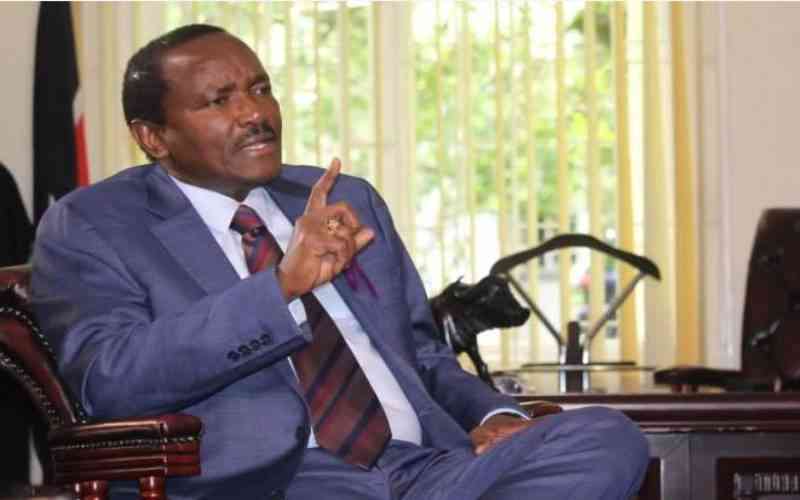 |
|
A teacher (left) ransacks the box of one of the students who were admitted to Form One at St Angela’s Girls Secondary School in Kitui County. [PHOTO: ANDREW KILONZI/STANDARD] |
By AUGUSTINE ODUOR
Kenya: Private primary schools say they have lost thousands of pupils to public institutions this year due to the Form One selection quota system that has disadvantaged candidates from academies.
Representatives of the academies yesterday said some 58,000 pupils in Standard Seven and Eight were transferred to public schools at the start of the first term last month.
The pupils, they alleged, were moved to public schools to improve their chances of being selected to join top secondary schools after the Kenya Certificate of Primary Education (KCPE) exam. Parents have apparently taken advantage of the three-month window to transfer their children, as the Kenya National Examination Council (Knec) registration deadline for candidates is March 31.
Kenya Private Schools Association (Kepsa) said they gathered the figures from their members across the country.
Kepsa Chief Executive Officer Peter Ndoro claimed private schools had lost over 100,000 pupils to public schools since the implementation of the quota system in 2011.
“We first felt the impact in 2012 when some 17,000 children were transferred to public schools. Last year, 42,000 left private academies and this is now worrying us,” he told The Standard yesterday.
Ndoro said the alarming trend, which he said is replicated in Bungoma, Kwale, Kisumu, and various parts of Central and Rift Valley regions, is likely to lead to the closure of some private schools.
“We are fearful that in two years, several academies will have closed down because of lack of candidates. For instance, a school in Narok that had 47 pupils in Standard Seven last year now has only nine candidates who returned to the school this year,” said Ndoro.
He pointed that the number of slots in top secondary schools allocated to private schools was slashed this year.
This year, Ndoro explained, only 4, 273 places were allocated to private schools down from 7,573 last year.
“In 2013, we were allocated some 46 per cent of the 16,727 vacancies. We considered it a better allocation because it was close to half. But this year we were only given 25 per cent of the 16,918 slots,” Ndoro said.
The implication of the quota system is that candidates from private schools with higher marks miss out on places in the 78 national schools.
Pauline Muhonja Senelwa, 13, sat her 2013 KCPE at Booker Academy in Mumias and scored 425 marks out of a possible 500. She had selected Moi Girls, Eldoret, Kenya High and Starehe Girls but failed to secure a place in all.
Yesterday, Ndoro said it is such analysis of the Form One selection that has prompted parents to withdraw their children from private schools when they are about to sit their examinations.
Stay informed. Subscribe to our newsletter
“The general perception out there is that it is no longer worthy to take your child to an academy because they will never get the best places in secondary schools, even with good performance,” said Ndoro.
“It is clear that pupils in public schools get fair treatment at selection. We have received reports from various private schools across the country and the trend is worrying,” he added.
Ignored six letters
The association accused top ministry officials of presiding over “the death” of private academies, which help ease the burden on public institutions.
He said private academies have some 1.3 million children. About 6,700 sat last year’s KCPE.
The association accused Education PS, Dr Belio Kipsang, of ignoring six letters addressed to him between November 17, 2013 and January 21, 2014 seeking talks on the issue.
One of the letters seen by The Standard reads: “As a result of this year’s (2014) selection, parents have transferred their children who are in Standard Seven and Eight from private schools to public schools.”
It adds: “As a result, we now have private schools which had a reasonable population in their classes (but) now have no pupils or have very few.”
The letter asks Kipsang to urgently call a meeting to address the situation. “The situation is so bad that if action is not taken very urgently, local private schools will not survive,” reads the letter by Kepsa National Chairman Ernest Wangai.
Yesterday, Kipsang told the The Standard the Government was open to negotiations.
“We have met them twice and have written to Kepsa inviting them for a meeting this Friday. We know their role in easing pressure in education and we want to seek a strong partnership so that they can invest in secondary schools as well,” Dr Kipsang said.
The PS explained the formula used this year is the same as that applied last year that ensured private candidates had a fair chance during selection. “It was a purely fair system and we do not aim to discriminate against any one,” he added.
Kenya National Parents Association and the Elimu Yetu Coalition (EYC) said the government does not have the capacity to handle a huge number of learners in primary schools, if private investors are pushed out of business.
“The government must invest heavily in expansion of secondary schools because that is the start of all these problems. They have over invested in national schools and ignored the other category of secondary schools,” said Janet Muthoni, EYC national coordinator.
The parents’ association boss, Mr Nathan Barasa, said public primary schools are already reeling under pressure from huge enrolment numbers and an exodus from private schools would compound the problem.
Quality education
Barasa said the Government has even failed to disburse the Sh1,025 per child government subsidy on time.
Kenya National Union of Teachers (Knut) urged the government to act quickly to foster quality education.
“What we all need is quality education and if that means partnerships then let’s do it. We should not lock out people who add value to the education of our children,” said Knut Secretary General Wilson Sossion.
In its Session paper No.1 of 2005 and No. 14 of 2012, the ministry admitted that it could not meet the demands of education and emphasised the need to partner with private investors.
 The Standard Group Plc is a
multi-media organization with investments in media platforms spanning newspaper
print operations, television, radio broadcasting, digital and online services. The
Standard Group is recognized as a leading multi-media house in Kenya with a key
influence in matters of national and international interest.
The Standard Group Plc is a
multi-media organization with investments in media platforms spanning newspaper
print operations, television, radio broadcasting, digital and online services. The
Standard Group is recognized as a leading multi-media house in Kenya with a key
influence in matters of national and international interest.
 The Standard Group Plc is a
multi-media organization with investments in media platforms spanning newspaper
print operations, television, radio broadcasting, digital and online services. The
Standard Group is recognized as a leading multi-media house in Kenya with a key
influence in matters of national and international interest.
The Standard Group Plc is a
multi-media organization with investments in media platforms spanning newspaper
print operations, television, radio broadcasting, digital and online services. The
Standard Group is recognized as a leading multi-media house in Kenya with a key
influence in matters of national and international interest.







